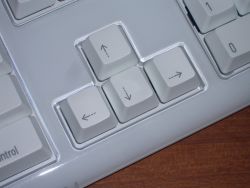Cursor keys

The cursor keys or arrow keys are the keys labelled with arrows provided for interactive navigation on a computer system. They move the text cursor and scroll through content on the screen. The standard arrangement has been the inverse-T layout for many years now, but historically there have been many different arrangements.
History[edit | edit source]
As shown below, a significant number of arrangements have been tried over the decades. Most keyboards today use the inverse-T arrangement, which was popularised by the 1982 DEC LK201 keyboard. While the LK201 is widely considered to have introduced this layout, the inverse-T arrangement long pre-dates the LK201. The ADDS Envoy 620 portable computer, introduced in 1972, used inverse-T cursor keys ten year earlier.<ref name="ADDS-Envoy-620" />
The modern tendency is for the cursor keys to be isolated as their own cluster. In the case of both the LK201 and the Envoy 620, the cursor keys were part of the navigation cluster. The IBM Model M most likely popularised the idea of separating them out from the rest of the navigation keys, and the Model M layout has remained the baseline standard from that day onwards.
Cursor keys by system[edit | edit source]
The following is not an exhaustive list, nor a guide to when specific designs were first used. It is simply an illustrative guide to the variety of layouts that were tried before the inverse-T arrangement become the de facto standard.
Lear Siegler ADM-3A (1976)[edit | edit source]
The ADM-3A added cursor keys to the ADM-3 terminal. The Vi/Vim editor uses the same cursor key as the author used an ADM-3A terminal.<ref name="Vi-wikipedia" />
Commodore PET (1977)[edit | edit source]
The Commodore PET (in both its chiclet and full-travel varieties), only had two cursor keys, one per axis. Unshifted, they produced Down and Right respectively. The VIC-20 (1981) and C64 (1982) followed but with the keys located just right of the right Shift key, allowing three-finger use more like with an inverse-T layout.
DEC VT100 (1978)[edit | edit source]
Apple III (1980)[edit | edit source]
The Apple III computer introduced the L-shaped arrangement of arrow keys seen on various keyboards throughout Apple's early product ranges. The keys had unusual double action key switches that repeated faster when pressed to the bottom <ref name="ytadrianblack"/>
BBC Microcomputer (1981)[edit | edit source]
DEC LK201 (1982)[edit | edit source]
The DEC LK201 keyboard popularised the now standard inverse-T layout.
Apple //e (1983)[edit | edit source]
The Apple //e introduced the linear arrangement used on later Apple II microcomputers, which was also found on early Macintosh computers before Apple started gradually switching to the inverse-T layout.
Amstrad CPC464 (1984)[edit | edit source]
The CPC464 keyboard was one of many that placed the arrow keys in a cross shape with a key in the centre between them. In this case it was the split-cursor text copy key, previously seen on the 1981 BBC Micro.
BBC Master Series (1986)[edit | edit source]
The Master Series range had an extended keyboard with a numeric keypad, and the cursor keys were split out into their own group with an unusual narrow arrangement, seen previously on some terminal keyboards.
WASD[edit | edit source]
The WASD keys are used as cursor keys in games to such an extent that numerous companies now manufacture custom keycaps for this group of keys. Some compact keyboards use these keys as the actual cursor keys when the function key is held. The specific letters vary depending on locale; for example, French keyboards use ZQSD instead.
References[edit | edit source]
<references> <ref name="ADDS-Envoy-620">Terminals — ADDS Envoy 620</ref> <ref name="ytadrianblack">Youtube. Adrian Black — The Apple III: My mini review and repair. Dated 2017-04-04. Viewed 2017-09-13.</ref> <ref name="Vi-wikipedia">Wikipedia — Vi editor</ref> </references>